Find the equation of an ellipse given center, and the length of major and minor axes | @ProfD
TLDRIn this educational video, the presenter guides viewers through the process of finding the equation of an ellipse in standard form, given its center and the lengths of its axes. The video begins with the center coordinates (5, -2), a major axis of length 16 parallel to the y-axis, and a minor axis of length 8. The presenter explains that since the major axis is vertical, the ellipse is vertical as well. Using the lengths of the axes, the video derives the values for 'a' and 'b', which are 8 and 4, respectively. The final equation of the ellipse is presented as (x - 5)^2 / 16 + (y + 2)^2 / 64 = 1. This concise tutorial is ideal for those looking to understand the mathematical principles behind ellipses and their standard form equations.
Takeaways
- 📚 The video is a tutorial on finding the equation of an ellipse in standard form.
- 📐 The ellipse's center is given as (5, -2), located in the fourth quadrant.
- 📏 The major axis of the ellipse is 16 units long and is parallel to the y-axis.
- 📏 The minor axis is 8 units long, making it half the length of the major axis.
- 🔍 The ellipse is vertical because the major axis is parallel to the y-axis.
- 📝 The equation for a vertical ellipse is \((x-h)^2/(b^2) + (y-k)^2/(a^2) = 1\).
- 🔢 The value of 'a' is calculated to be 8 by setting \(2a = 16\) and solving for 'a'.
- 🔢 The value of 'b' is calculated to be 4 by setting \(2b = 8\) and solving for 'b'.
- 📝 The final equation of the ellipse is \((x-5)^2/16 + (y+2)^2/64 = 1\).
- 👨🏫 The video is presented by Prof D, who encourages questions in the comment section.
- 👋 The video concludes with a sign-off from Prof D, indicating the end of the tutorial.
Q & A
What is the main topic of the video?
-The main topic of the video is to demonstrate how to find the equation of an ellipse in standard form using its center and the lengths of its axes.
What are the coordinates of the center of the ellipse given in the video?
-The center of the ellipse is given as (5, -2), which is in the fourth quadrant.
What is the length of the major axis of the ellipse mentioned in the video?
-The length of the major axis of the ellipse is 16 units, which is parallel to the y-axis.
What is the length of the minor axis of the ellipse mentioned in the video?
-The length of the minor axis of the ellipse is 8 units.
What type of ellipse is being discussed in the video?
-The video discusses a vertical ellipse, which has its major axis parallel to the y-axis.
What is the general equation of a vertical ellipse in standard form?
-The general equation of a vertical ellipse in standard form is \(\frac{(x-h)^2}{b^2} + \frac{(y-k)^2}{a^2} = 1\), where \(h\) and \(k\) are the coordinates of the center.
How is the value of 'a' determined from the major axis length in the video?
-The value of 'a' is determined by the formula \(2a = \text{length of the major axis}\). In the video, \(2a = 16\), so \(a = 8\).
How is the value of 'b' determined from the minor axis length in the video?
-The value of 'b' is determined by the formula \(2b = \text{length of the minor axis}\). In the video, \(2b = 8\), so \(b = 4\).
What is the final equation of the ellipse in standard form as given in the video?
-The final equation of the ellipse in standard form is \(\frac{(x-5)^2}{4^2} + \frac{(y+2)^2}{8^2} = 1\), which simplifies to \(\frac{(x-5)^2}{16} + \frac{(y+2)^2}{64} = 1\).
Who is the presenter of the video?
-The presenter of the video is Prof D.
What does the presenter suggest viewers do if they have questions or need clarifications?
-The presenter suggests that viewers should put their questions or clarifications in the comment section below the video.
Outlines
📚 Introduction to Finding the Ellipse Equation
The video begins with a warm welcome and an introduction to the topic of finding the equation of an ellipse in standard form. The instructor outlines the prerequisites for the lesson, which include knowing the center of the ellipse and the lengths of its major and minor axes. The specific example provided has the ellipse centered at (5, -2) with a major axis of length 16 parallel to the y-axis and a minor axis of length 8.
📐 Understanding the Ellipse's Orientation and Axes
The instructor explains that the ellipse is vertical since its major axis is parallel to the y-axis, which means it's oriented vertically on the coordinate plane. The center of the ellipse is in the fourth quadrant, with coordinates (5, -2). The major axis is the longest diameter of the ellipse, and in this case, it is given as 16 units long, which is twice the length of the semi-major axis (2a = 16). The minor axis is the shortest diameter and is given as 8 units long, which is twice the length of the semi-minor axis (2b = 8).
🔍 Calculating the Semi-Major and Semi-Minor Axes
The video proceeds with the calculation of the semi-major axis (a) and the semi-minor axis (b) of the ellipse. The instructor divides the length of the major axis by 2 to find that a = 8. Similarly, the length of the minor axis is divided by 2 to find that b = 4. These calculations are crucial for determining the coefficients in the standard form equation of the ellipse.
📝 Deriving the Standard Form Equation of the Ellipse
With the values of a and b determined, the instructor derives the standard form equation of the ellipse. For a vertical ellipse, the equation is given by (x - h)²/b² + (y - k)²/a² = 1, where (h, k) is the center of the ellipse. Substituting the values of h = 5, k = -2, a = 8, and b = 4 into the equation, the instructor simplifies it to (x - 5)²/16 + (y + 2)²/64 = 1, which represents the ellipse in standard form.
👋 Conclusion and Invitation for Feedback
The video concludes with a summary of the process and an invitation for viewers to ask questions or seek clarifications in the comment section below. The instructor, Prof D, thanks the viewers for watching and signs off with a friendly farewell, indicating the end of the educational content.
Mindmap
Keywords
💡Ellipse
💡Standard Form
💡Center
💡Major Axis
💡Minor Axis
💡Axis Length
💡Vertical Ellipse
💡Equation Derivation
💡Semi-major Axis (a)
💡Semi-minor Axis (b)
💡Prof D
Highlights
Introduction to finding the equation of an ellipse in standard form.
Providing the center of the ellipse at coordinates (5, -2).
Identifying the major axis length as 16 and parallel to the y-axis.
Determining the minor axis length as 8.
Explanation of the ellipse being in the fourth quadrant.
Clarification that the ellipse is vertical due to the major axis orientation.
Introduction of the standard equation for a vertical ellipse.
Substitution of the center coordinates into the ellipse equation.
Calculation of the semi-major axis length (a) as 8.
Calculation of the semi-minor axis length (b) as 4.
Substitution of axis lengths into the ellipse equation.
Final simplification of the ellipse equation in standard form.
Presentation of the complete equation: (x-5)^2/16 + (y+2)^2/64 = 1.
Invitation for viewers to ask questions or seek clarifications.
Closing remarks and sign-off by Prof D.
Transcripts
Browse More Related Video

How to find the equation of an ellipse given foci and vertices | @ProfD

Graphing Conic Sections Part 2: Ellipses

STANDARD EQUATION OF PARABOLA TO ITS GENERAL FORM

How to find the equation of Hyperbola given vertex, and the equation of asymptote

Find the equation of Hyperbola given vertices and asymptote

Properties of Logarithms
5.0 / 5 (0 votes)
Thanks for rating: